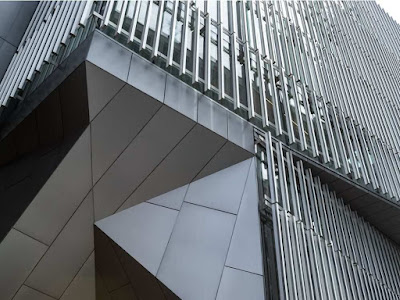The theme of the new space is peace and well-being. Several impressive sculptural works were commissioned from regional artists to enhance the interior decor. In Quebec, all public buildings must set aside 1% of their construction budgets for art, and ironically this applies to art museums as well.
The new pavilion is designed to offer exciting views of the city on its outer edges, while protecting the collection in the inner core of the building. White oak, grey granite, aluminum and concrete feature prominently in the interior design, which includes impressive gathering places and facilities to extend the educational mission of the museum. Several of the gallery walls are especially finished to express the theme of the room's contents: regal, stencilled motifs to enhance the Napoleonica collection, ornate but subtle latticework to showcase the Orientalism display, and a forest-like light effect, complete with birdsong, to complement the pastoral masterpieces.
The Pavilion for Peace was supported by Michal and Renata Hornstein who, in 2012, generously donated 75 works from their collection of Old Masters, valued at over $75 million, and contributed to the building fund. The Hornsteins, both Holocaust survivors, were actively involved in the planning of the new wing but sadly did not live to see the opening.
In late January the exhibition "Chagall: Colour and Music" will open, giving us yet another reason to visit our new MMFA.
And in the coming months, as part of Montreal's 375th anniversary celebration, Bishop Street will become a pedestrian plaza, linking Concordia University to the Museum. The Museum's outdoor sculpture garden will expand from Avenue du Musée to Bishop Street, cementing the ongoing relationship between the two institutions.



No comments:
Post a Comment